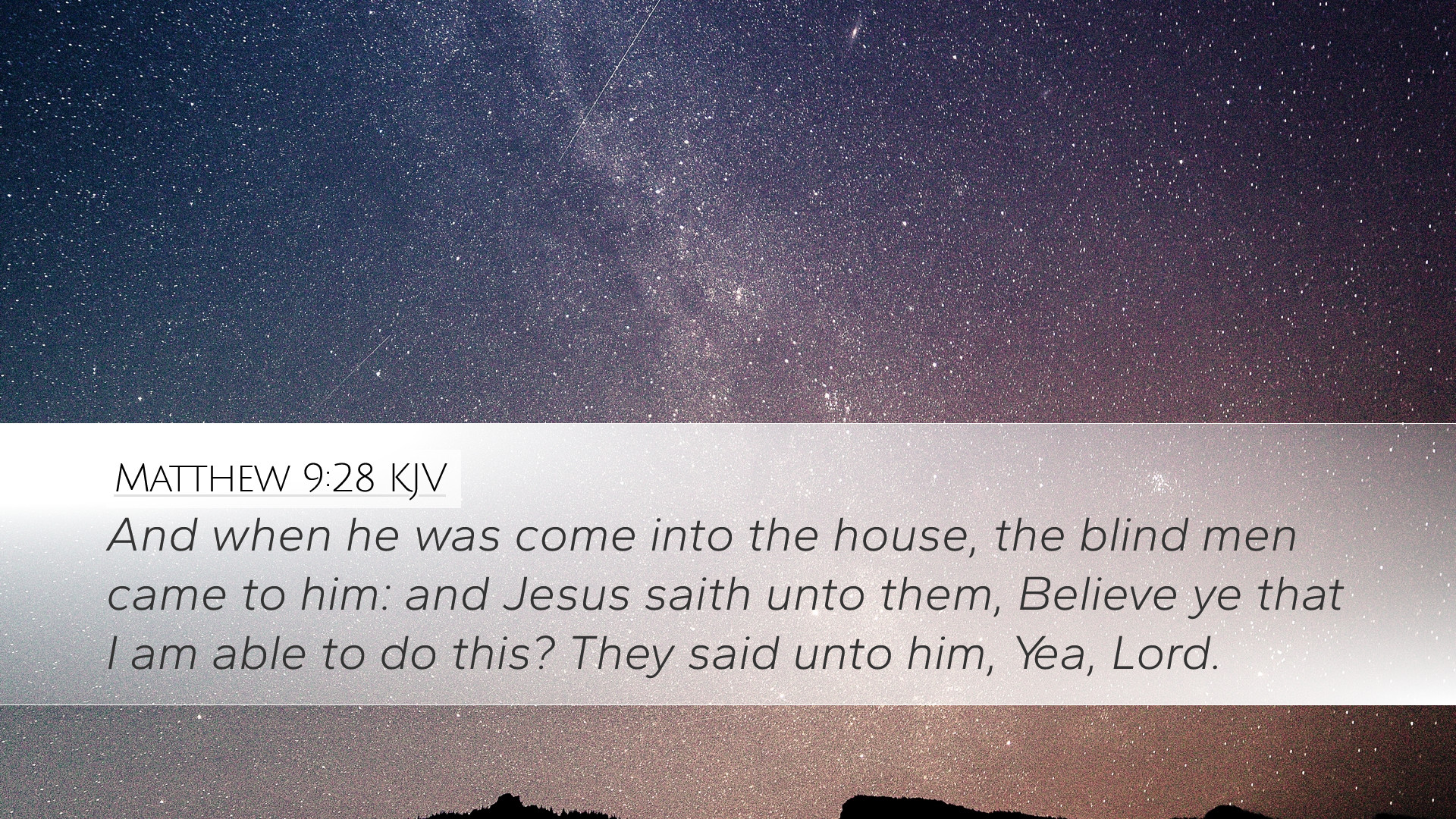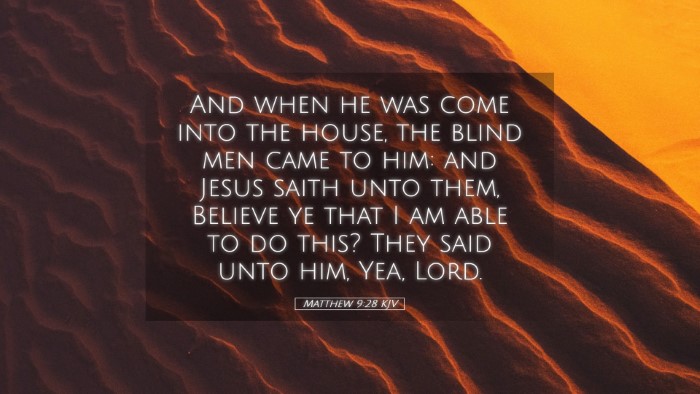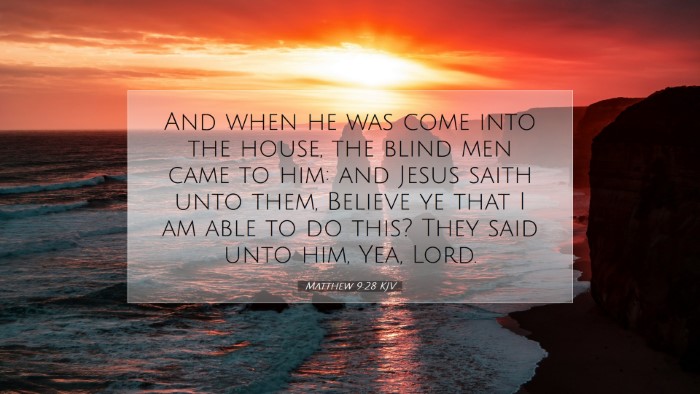Commentary on Matthew 9:28
Text of Matthew 9:28: "And when he was come into the house, the blind men came to him: and Jesus saith unto them, Believe ye that I am able to do this? They said unto him, Yea, Lord."
Introduction
This passage from the Gospel of Matthew illustrates a significant moment in Jesus’ ministry, emphasizing faith, belief, and the power of Christ to heal. It is crucial to understand this verse within its broader literary and theological context. Insights from esteemed biblical commentaries provide depth to this interaction between Jesus and the blind men, inviting theological reflection and applicatory considerations for modern readers.
Contextual Analysis
Matthew 9:28 occurs after a series of miracles performed by Jesus, which amplify His authority and divine nature. The preceding verses illustrate His ability to forgive sins and perform miraculous healings. The encounter with the blind men is a pivotal moment that demonstrates the necessity of faith in the process of miraculous healing.
Setting of the Encounter
As Matthew indicates, this event occurs "when he was come into the house," suggesting a retreat from public ministry to a more private domain. Scholars, such as Adam Clarke, note that this shift implies a safe space for deeper discussions on faith and understanding the nature of Jesus' mission.
Symbolism of Blindness
The blindness of the men symbolizes not only their physical inability to see but also the spiritual blindness present in society at large. Matthew Henry suggests that their request for healing reflects a desire for spiritual insight as well. The healing that results serves dual purposes: physical restoration and a revelation of divine truth.
Faith and Belief
Jesus' inquiry, "Believe ye that I am able to do this?" serves multiple functions:
- Challenge to Faith: Christ challenges the blind men to articulate their faith. This question serves as a vital point of self-examination regarding their belief in His power.
- Recognition of Christ's Authority: By prompting their confession of faith, Jesus establishes His identity as the Messiah who has the authority over sickness and blindness.
- Connection to the Kingdom of God: The act of believing in Jesus' capabilities connects the healing miracles to the greater theme of the Kingdom of God being realized through faith.
Responses of the Blind Men
In response to Jesus’ question, the blind men declare, "Yea, Lord." This short but profound affirmation embodies their faith. Albert Barnes importantly remarks on their acknowledgment of Jesus as "Lord," which indicates their recognition of His divine authority and power. Their responsive faith is pivotal; it not only shows their belief in His ability to heal them but also highlights an essential aspect of receiving miraculous works: active participation through faith.
Active Faith in Action
The implication of their response emphasizes that faith is not a passive belief but an active conviction that engages with the power of Christ. Matthew Henry elaborates on this persuasive point, asserting that faith often precedes the act of receiving and is a necessary condition for miracles in the lives of believers.
Theological Implications
The interplay of sight and blindness in this passage also invites deeper theological reflection on the nature of faith and revelation:
- Miracles as Signs: Miracles serve as signs pointing to who Jesus is. They reveal the nature of God’s Kingdom, characterized by healing, restoration, and wholeness.
- God’s Sovereignty and Mercy: The passage underscores God’s sovereign grace in the lives of those who call out in faith. Clarke posits that this narrative reaffirms God’s willingness to extend mercy to those who are spiritually and physically needy.
- The Role of Faith in Salvation: This interaction with the blind men reinforces the theological principle that faith is integral to salvation. Their belief is depicted as the means through which they receive Jesus’ healing touch.
Applicatory Considerations
For pastors, theologians, and Bible scholars, Matthew 9:28 presents several applicatory considerations:
- Encouraging Active Faith: This passage encourages believers today to articulate their faith actively and to bring their needs before Jesus with the confidence that He is able and willing to intervene.
- Understanding Spiritual Blindness: The theme of blindness serves as a reminder to consider areas in life where spiritual sight may be clouded, urging continual reflection, repentance, and prayer for clarity and insight.
- Affirming Christ’s Lordship: Believers are called to affirm Christ's position as Lord in their lives, recognizing His authority over all circumstances, including health, challenges, and spiritual struggles.
Conclusion
Matthew 9:28 conveys profound truths about faith, healing, and divine authority. Drawing from public domain commentaries enriches our understanding of this passage, inviting all readers to engage with the text meaningfully. As leaders and scholars reflect on this encounter, they must consider the faith of the blind men as a model for contemporary believers, underscoring the necessity of recognizing Jesus as Lord and the power He holds to transform lives. Ultimately, this passage calls believers to a deeper faith that actively engages with the miraculous works of Christ.


